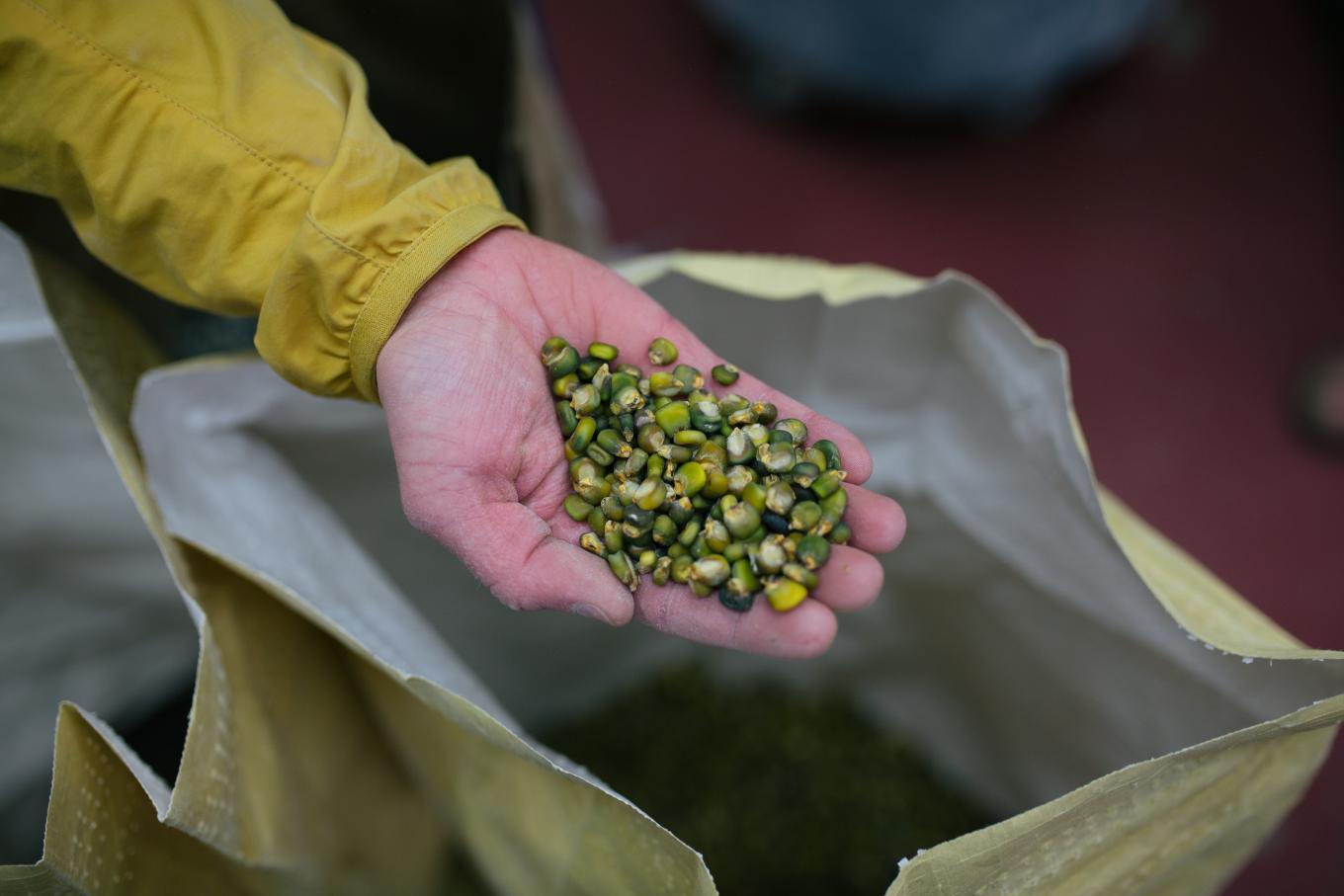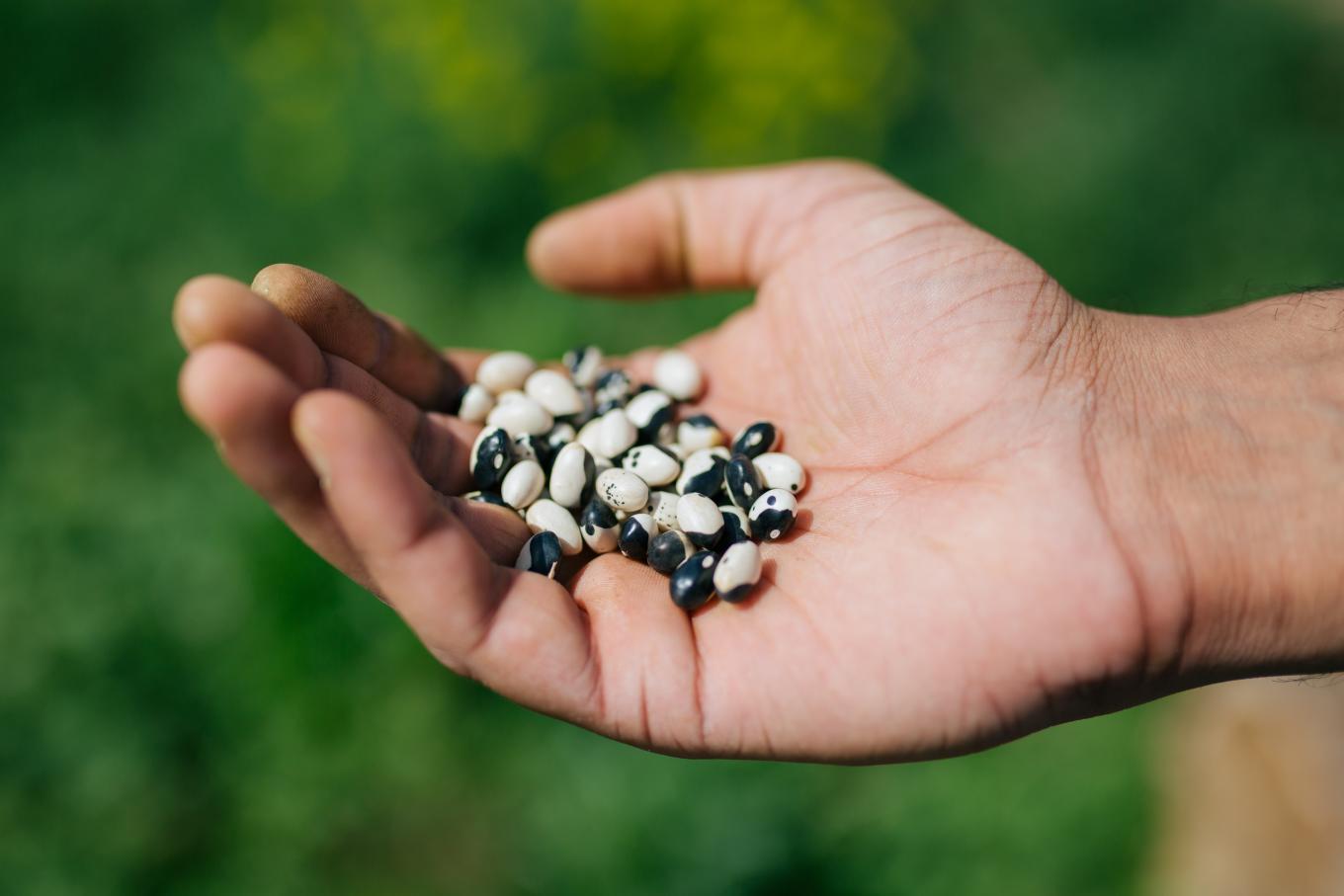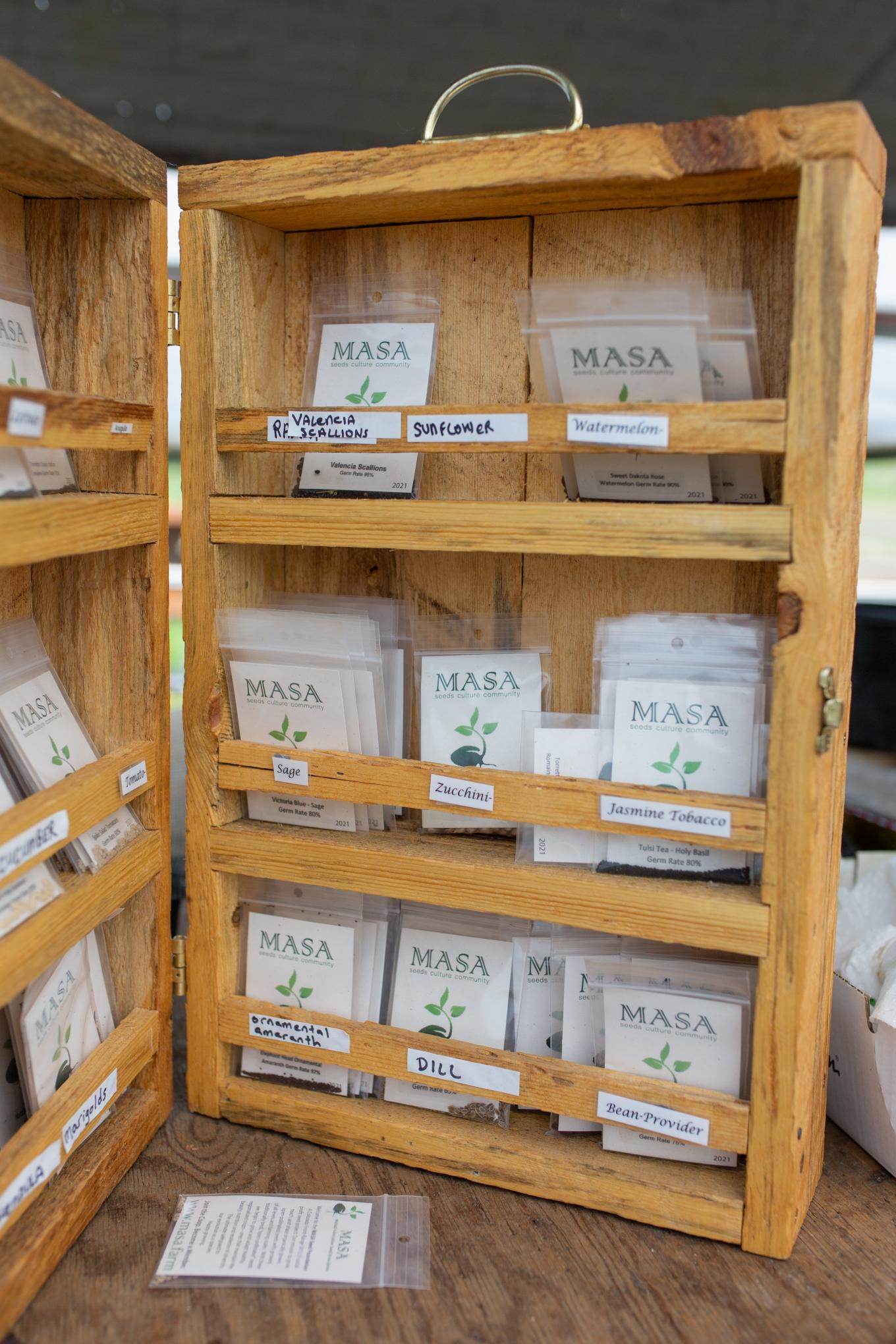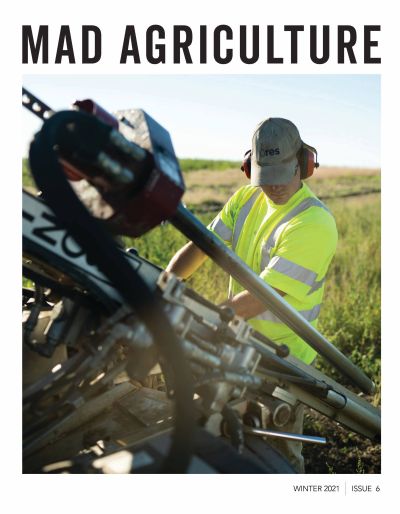
The Mad Agriculture Journal
Gone to Seed
Published on
November 12, 2021
Written by
Sophia Piña-McMahon
Photos by
Sophia Piña-McMahon
Imagine a world where watermelons have orange flesh and every kernel on an ear of corn is a different color. A world where tomatoes are black, carrots are red, and cucumbers are white. Sounds like science fiction, doesn’t it? Well, it’s not. That world is our world.
Orangeglo watermelons, Glass Gem corn, Chichiquelite tomatoes, Atomic Red carrots, and Dragon’s Egg cucumbers are all very real varieties of the fruits and vegetables we know and love. Each of these crops are heirloom varieties — ones that were being grown before the 1950s and haven’t changed much since. You can’t find them in your local grocery store, and most of us will never taste them either. Like the animals in our zoos, many of these crops are endangered or near extinction — and many more have been irreversibly lost. This trend has profound ecological, cultural and nutritional implications, and it’s the direct result of a significant shift in how farmers interface with some of the smallest, mightiest actors in our food system: seeds.
The most recent study to determine the scope of our food seed variety loss was conducted in 1983 by the Rural Advancement Foundation International. After comparing USDA listings of seed varieties in 1903 with listings from the U.S. National Seed Storage Laboratory in 1983, they concluded that 93% of our food seed varieties had gone extinct. We went from 497 varieties of lettuce to just 36, 544 varieties of cabbage to only 28, and 307 varieties of corn to a mere 12. The list goes on, and the trends are the same across the board. More up-to-date studies are needed, but in all likelihood the numbers have gotten worse as the seed industry has grown more consolidated. While the facts are staggering, it is still possible to save the diversity that remains. Efforts to do so must start with a reckoning over the past treatment of seeds in the United States.
From Agriculture to Agroindustry
Until the turn of the 20th century, it was common practice for farmers to select, save and share the seeds from their best crops each year to plant for the following season. Over time, their efforts produced a rich diversity of crop varieties, each uniquely adapted to specific environments, cultures, and cuisines. The practice has particularly deep roots in Indigenous agriculture, where specific crops are relied upon not only for consumption, but also for social, cultural, and spiritual purposes. Pre-contact, Indigenous communities developed highly complex systems of seed saving using generational knowledge on optimal season times for seed saving, pollination patterns, and highly durable seed storage systems.
Some of America’s early leaders also understood the importance of seed saving, seeing crop diversity as a way to strengthen agriculture and boost the economy. In 1839, prior to the formation of the USDA, Congress began funding a program that coordinated the collection of novel crop varieties and regularly distributed their seeds to American farmers for free. Farmers were then encouraged to test and save seeds from the crops that grew best in their fields. In fact, some of the heirlooms that resulted from this program are still grown today, including Red Fife wheat—a variety being grown in Colorado’s Front Range.

In the early 1920s, the first hybrid corn seed became commercially available, kick-starting an era of rapid development in the seed sector. Once hybrid seeds came into the picture, the agriculture industry had a greater ability to breed crops for desired traits—usually size and yield—and started to abandon diversity and resilience.
Around the same time that hybrids hit the market, Congress ended their seed saving and crop diversity program. A few decades later, the Green Revolution in the 1950s brought genetically engineered seed, chemical inputs, and mechanization into the mix. Agriculture turned into agroindustry, and standardization, uniformity, and profit became the name of the game. Farmers were soon under increased economic and legislative pressure to use high-yielding, genetically engineered seed over the stable, locally-adapted, heirloom varieties of the past.
The final blow to seeds came in the 1980s, when the U.S. government decided that crops could be patented. The decision allowed large seed corporations to treat genetically engineered crops as “inventions” and require farmers to purchase a license or lease to use commercial seeds. These agreements specify a time frame—often about a year—after which the farmers must buy more seed. Saving commercial seeds from season to season is not permitted, and farmers run the risk of patent violations if they do it. Today, most commercially-available seeds are also genetically engineered so that they will only perform well if used in combination with the chemical inputs produced by the same company. The resulting dependence on chemicals has been devastating for soil and human health.
Four companies now control more than 60% of the global seed market. And out of the hundreds of thousands of known edible plant species, 75% of the world’s food is generated from just 12 crops. All told, the consolidation of the seed industry has resulted in fewer, more profitable crop varieties at the expense of biodiversity and farmer independence. It’s also impacted the diversity in our diets and threatened the existence of culturally significant crops. Fortunately, a growing community of seed stewards recognize this and are actively working to defend and improve our seed supply, determined to bring diversity back to our farms, gardens, and tables.
Towards Seed Sovereignty
A major concern with corporate control of seeds is that large agricultural companies focus on producing varieties that support their monetary interests rather than varieties that support human and environmental health. Seed stewards focus on the latter—they select and save seeds for specific nutritional, ecological, cultural, aesthetic, culinary, or spiritual qualities to a given region rather than solely for size or yield.
The process of seed saving allows for locally adapted heirloom varieties (also known as ‘landraces’) to emerge over time. Having evolved with the land over decades—or in some cases centuries—landrace varieties are well suited to specific climates and soils, so they often require fewer external inputs like water, fertilizers and pesticides. Preserving these varieties is essential for building a resilient and regenerative food future—one that helps farmers thrive financially and ecologically, gives back to the land, and produces safe, nutritious food for all.
Farmers, gardeners, and activists working to protect landrace and heirloom seed varieties are the heart and soul of the seed sovereignty movement. Defined as “the farmer’s right to breed and exchange diverse, open-pollinated seeds which can be saved and which are not patented, genetically modified, owned or controlled by emerging seed giants,” seed sovereignty is vital to maintaining biodiversity and food security, increasing farmer independence, and preserving invaluable indigenous seed varieties and their stories for future generations.
Seed sovereignty advocates maintain that if we lose control over our seeds, we lose control over the very foundation of our food chain. Numerous voices in the food and environmental movements have risen over the years to amplify this rallying cry. In Colorado’s Front Range, multiple farmers and organizations have heeded their call.

Front Range Seed Stewards
When it comes to seed saving expertise in the Front Range, one of the first people the food and farming community turns to is Richard Pecoraro of MASA Seed Foundation, a non-profit seed saving organization and farm located in Boulder, Colorado. Pecoraro has been a seedsman working in organic agriculture for over 40 years, and over the decades he has witnessed true crop resilience and endured the many challenges inherent to farming and seed saving. But he will always be the first to share his lasting fascination with seeds and seed work.
“Growing, collecting, and regrowing seeds, then watching how the plants adapt wherever you go with those seeds—it all makes you realize that you’re just part of the seed’s story,” said Pecoraro. “And the more you become a part of the story, the better. It gives meaning to what you are doing, and there is a value to that which is not measured monetarily, but soulfully.”
Many heirloom crops have stood out to him over the years as particularly captivating. One of them is corn—but not the conventional yellow variety found in grocery stores or the ones grown for high fructose corn syrup and ethanol, planted all across the state of Iowa. No—the corn varieties that stick with Rich are the corns of the Ancestral Puebloans. “In the 80s, I was introduced to Native American corn from the Four Corners region,” he said. “We still have varieties that we grow from the seed strains of those days—the Anasazi strain and the Hopi Pink strain. Those two are well adapted to regions like Colorado and they always stand out as great crops here.”
Puebloan corns alone illustrate the immeasurable value of saving seed. The Anasazi corn seed grown at MASA is a strain that originated from northern New Mexico cave findings. It grows strong and tall, produces multicolored kernels, and is one of the oldest varieties of corn in North America. Similarly, the rare Hopi Pink strain grown at MASA is bright, strong, drought resistant, high in protein, highly productive, and considered one of the best flour corns that can be grown today. To save and grow these unique varieties is to save story, nutrition, diversity, and ecological resilience.
A group that further champions this work is FrontLine Farming, a BIPOC and womxn-led farmer advocacy and food justice organization based in Denver, Colorado. They operate three urban farms in the metro area and save seeds at each one, emphasizing the collection of regionally adapted and culturally significant crops for their growing seed archive.
At their Sister Gardens location, FrontLine has dedicated three terraces to growing crops specific to African, Middle Eastern and Four Corners bioregional foodways. Co-Founder and Executive Director, Fatuma Emmad, shared that these efforts to save seed from cultural crops can be traced back to enslaved African women, who brought seeds across the Atlantic by braiding them into their hair, realizing that they may never see their homes and fields again. Emmad hopes that through both seed production and education, FrontLine can help educate their community about the value in saving seeds and make it more accessible to everyone.
“Things like seeds or water or air have become so technocratic that we’ve come to think someone has to have all of these degrees or whatnot to be able to do it. But really, we need everybody to be seed saving now,” said Emmad. “Even if it’s just in your backyard and you grow out one squash and save the seeds from that, that contributes to the overall viability of the varieties that we’re losing at exponential rates. We’re only going to be able to keep doing that with everybody’s help.”

Emmad and Pecoraro both made it clear that somewhere in the transition from agriculture to agroindustry, we lost an innate connection to seeds and their stories. Their work is a reminder that saving seeds isn’t just about preserving beautiful, unique varieties of fruits and vegetables and adapting them to our bioregion. It’s also about helping us all maintain a physical connection with life’s past and future evolution.
Seeds are Life
Seeds might seem like small actors, but they serve as the blueprint for our entire food system. A change at the seed level impacts everything afterwards, from chemical usage to soil health to biodiversity and consumer well-being. When seeds are considered corporate property and bred with a year-long expiration date, they are treated by growers as such—fleeting inputs with a story that begins and ends with corporate America. But seeds that have stood the test of time, carrying the memories of all the people and places that touched them previously…those are cared for in the way that all food should be—with a deep reverence for place and past.
“I love teaching seeds to kids because when I do, I’ll tell them: ‘This seed is living. Pray when you’re planting it. Care for it,’” said Emmad. “Other people would think I’m a hippy, but not the kids. The kids will pray over every seed. I’ll tell them that when you take a small sunflower seed, it seems like nothing. But that seed will become this huge, six-foot tall plant! And a seed is like a child, you know. People say that you’re not big enough, but all of that growth is within you. Just like all of that potential is within a seed.”
Perhaps we would all do well to appreciate seeds as children do, treating them like the living beings that they are rather than as disposable inputs. As the first link in our food chain and repositories of future life on Earth, they are critical to our efforts to build a more sustainable, resilient, and just food system. By supporting farmers, gardeners, and organizations that preserve heirloom seeds, we can help maintain biodiversity and food security on this planet. Even by trying it out for ourselves or sharing seed stories with friends, we can make a difference. Because the more that we advocate for seeds and the many varieties that still make up our food system, the healthier and more resilient our food system will be.
